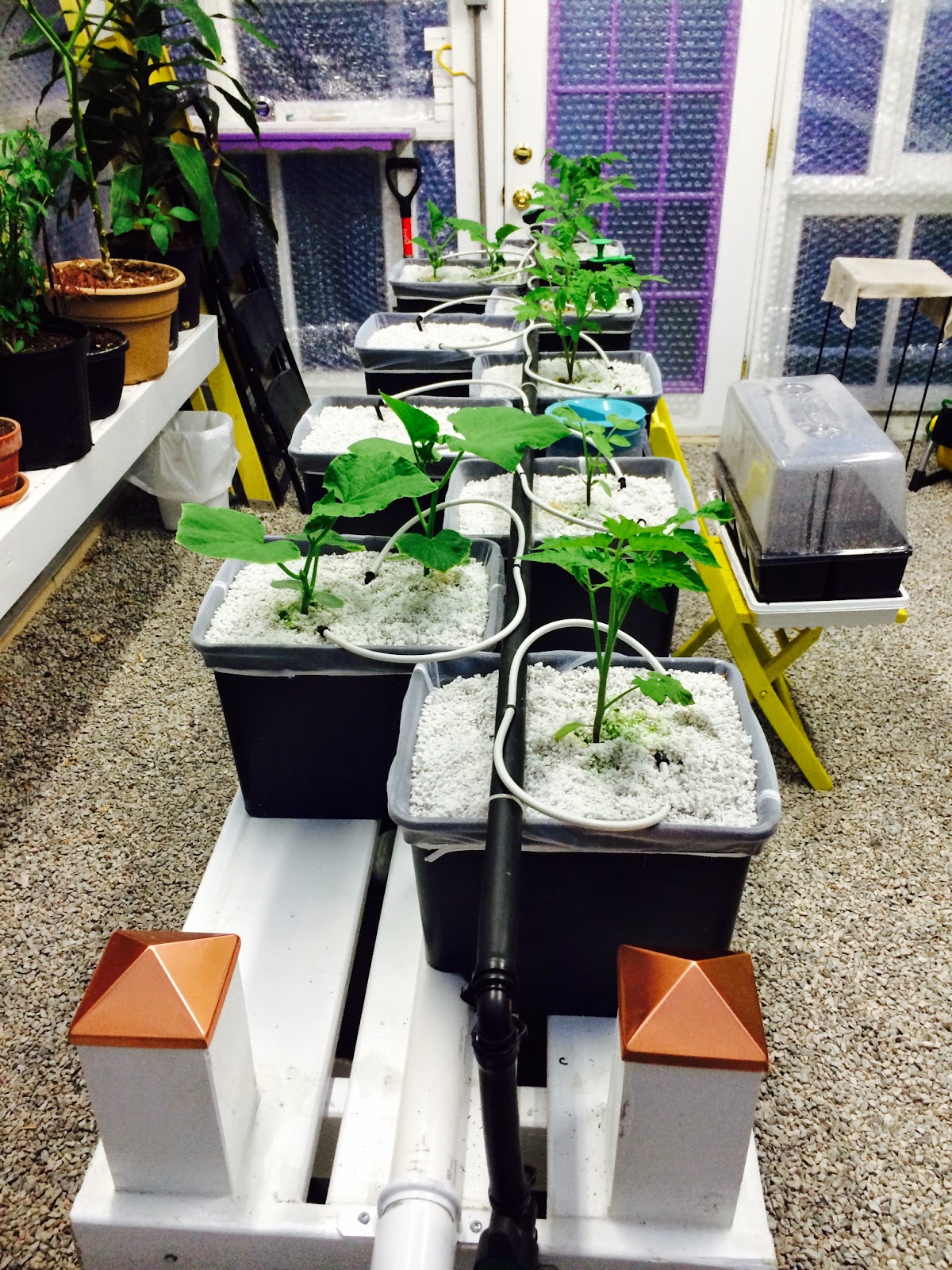Hydroponic Bucket System
You are on Page 5 of our ten page series on hydroponic bucket systems. Click on any of the below pages to jump to that page.
Page 1 Page 2 Page 3 Page 4 Page 5 Page 6 Page 7 Page 8 Page 9 Page 10

A hobbyist bucket system growing a variety of plants. Note the plants to the left, potted in conventional soil and pots. There is no rule saying a grower must choose one system to the exclusion of all others. A more helpful guideline might be to use whatever works best, given your interests, resources and goals, for the plants you wish to grow. An eclectic system like the above can be perfectly functional and productive. Photo courtesy of Hydroponic Pioneer.
Which Crops Don't Work in Bucket Systems?
As we’ve already seen, anything can potentially be grown in buckets. However, some plants are more cost effectively grown in other systems. Small plants, those with small root systems, and annuals or short-lived plants are much better suited to systems like NFT, flood and drain, and/or raft systems. For hobbyists, this distinction may not matter much. If small scale growers want to have a wide variety of plants in their operation, the bucket system is flexible enough that it can accommodate just about anything. It could very easily be used to grow a handful of tomatoes, a few pumpkins, some salad greens, some herbs, carrots and onions, and even a batch or two of peas or beans. In that context, minor inefficiencies per plant is just noise. Furthermore, the uniform hydroponic method can streamline the operation significantly compared to having different growing systems for different crop types. However, for commercial vine growers who want to optimize production for salad greens, small herbs, annuals, etc, other hydroponic systems are a better fit. Buckets would cost quite a bit more on a per-plant basis for these crops.
Estimated Cost
Hydroponic bucket systems are one of the more affordable options for hydroponic production, for several reasons. First, the buckets themselves can be purchased in whatever quantity makes sense for the grower. No minimum or maximum size is required. For growers just getting into hydroponics, they can purchase buckets as funds are available rather than all at once, which may make initial system setup easier to afford.
Second, the buckets don’t need any sort of stand or frame (aside from trellising for climbing plants). Almost every other form of hydroponics requires a stand of some kind for the containers, and those stands need to be rugged enough to support the weight of the crop, the growing media (if any), and the nutrient solution. For systems like flood and drain, this can require considerable support. For deep water culture, the rafts need to float in a large pool which similarly must be contained or supported. Even for NFT, the channels must be supported somehow, and at a very precise angle to provide for proper movement of nutrient through the channel. Bucket systems don’t have any of those concerns. The buckets just sit directly on the floor or ground.
Two issues vary enough from one system to another, that they might be cheaper in one scenario while considerably more expensive in another. The first issue is whether a reservoir is used for the nutrient solution, versus having a computerized injection system. The latter is expensive enough that most hobbyists and small-scale operations don’t use them. The acquisition cost and employee training required for operation, cancels out the savings provided by optimal nutrient delivery. A reservoir is much, much cheaper for smaller systems.
The second issue is whether a drain line is used for the buckets. Many small systems simply “run to drain” or “run to waste”, which means there is no system for returning the nutrient back to a reservoir. Fresh nutrient solution is delivered to the buckets once, and some of those nutrients are taken up by the plants. The rest is allowed to leave the bucket and simply soak into the ground or run off to a drain or sewer line. The cost of additional nutrient solution is offset by the lack of a drain line to purchase an maintain.
I should caution that this approach used to be fairly common, but it has become less so in recent years. Some growers simply consider this practice wasteful, and install the drain lines so that they can reuse the nutrients over and over again. They recover the cost of the drain line by recycling the nutrient solution instead of continually providing new solution. Other growers install the drain lines, and collect the used nutrient solution in a separate container to be used as fertilizer for soil-based gardening or landscaping. Here again, the cost of the drain line is offset by using the nutrition solution as fully as possible Other growers are required to run drain lines by their jurisdiction and/or by their particular growing circumstances. For instance, a hydroponic operation which leases warehouse space would almost certainly be required to install drain lines rather than allow nutrient solution to run all over the floor. In any case, it’s a good idea to check your jurisdiction in advance to see if drain lines are required by code.
BACK NEXT
Click any of the following links to jump to that page:
Page 1 Page 2 Page 3 Page 4 Page 5 Page 6 Page 7 Page 8 Page 9 Page 10